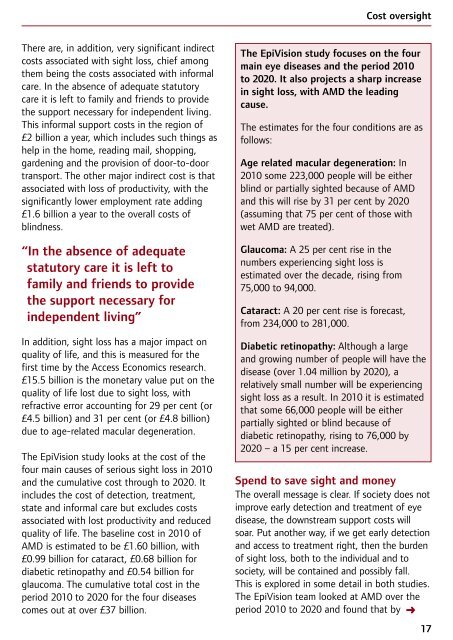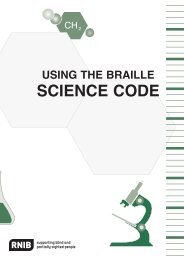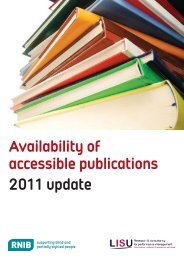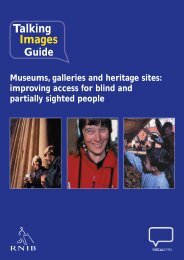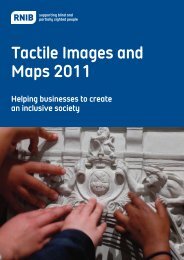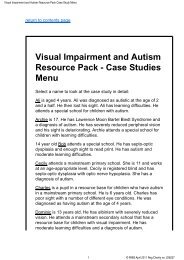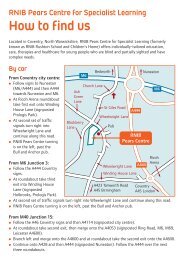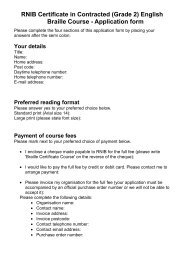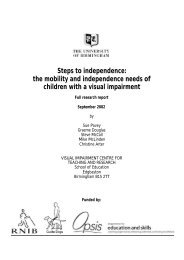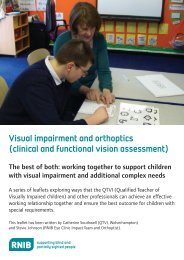Reflections on sight loss - RNIB
Reflections on sight loss - RNIB
Reflections on sight loss - RNIB
Create successful ePaper yourself
Turn your PDF publications into a flip-book with our unique Google optimized e-Paper software.
Cost over<strong>sight</strong><br />
There are, in additi<strong>on</strong>, very significant indirect<br />
costs associated with <strong>sight</strong> <strong>loss</strong>, chief am<strong>on</strong>g<br />
them being the costs associated with informal<br />
care. In the absence of adequate statutory<br />
care it is left to family and friends to provide<br />
the support necessary for independent living.<br />
This informal support costs in the regi<strong>on</strong> of<br />
£2 billi<strong>on</strong> a year, which includes such things as<br />
help in the home, reading mail, shopping,<br />
gardening and the provisi<strong>on</strong> of door-to-door<br />
transport. The other major indirect cost is that<br />
associated with <strong>loss</strong> of productivity, with the<br />
significantly lower employment rate adding<br />
£1.6 billi<strong>on</strong> a year to the overall costs of<br />
blindness.<br />
“In the absence of adequate<br />
statutory care it is left to<br />
family and friends to provide<br />
the support necessary for<br />
independent living”<br />
In additi<strong>on</strong>, <strong>sight</strong> <strong>loss</strong> has a major impact <strong>on</strong><br />
quality of life, and this is measured for the<br />
first time by the Access Ec<strong>on</strong>omics research.<br />
£15.5 billi<strong>on</strong> is the m<strong>on</strong>etary value put <strong>on</strong> the<br />
quality of life lost due to <strong>sight</strong> <strong>loss</strong>, with<br />
refractive error accounting for 29 per cent (or<br />
£4.5 billi<strong>on</strong>) and 31 per cent (or £4.8 billi<strong>on</strong>)<br />
due to age-related macular degenerati<strong>on</strong>.<br />
The EpiVisi<strong>on</strong> study looks at the cost of the<br />
four main causes of serious <strong>sight</strong> <strong>loss</strong> in 2010<br />
and the cumulative cost through to 2020. It<br />
includes the cost of detecti<strong>on</strong>, treatment,<br />
state and informal care but excludes costs<br />
associated with lost productivity and reduced<br />
quality of life. The baseline cost in 2010 of<br />
AMD is estimated to be £1.60 billi<strong>on</strong>, with<br />
£0.99 billi<strong>on</strong> for cataract, £0.68 billi<strong>on</strong> for<br />
diabetic retinopathy and £0.54 billi<strong>on</strong> for<br />
glaucoma. The cumulative total cost in the<br />
period 2010 to 2020 for the four diseases<br />
comes out at over £37 billi<strong>on</strong>.<br />
The EpiVisi<strong>on</strong> study focuses <strong>on</strong> the four<br />
main eye diseases and the period 2010<br />
to 2020. It also projects a sharp increase<br />
in <strong>sight</strong> <strong>loss</strong>, with AMD the leading<br />
cause.<br />
The estimates for the four c<strong>on</strong>diti<strong>on</strong>s are as<br />
follows:<br />
Age related macular degenerati<strong>on</strong>: In<br />
2010 some 223,000 people will be either<br />
blind or partially <strong>sight</strong>ed because of AMD<br />
and this will rise by 31 per cent by 2020<br />
(assuming that 75 per cent of those with<br />
wet AMD are treated).<br />
Glaucoma: A 25 per cent rise in the<br />
numbers experiencing <strong>sight</strong> <strong>loss</strong> is<br />
estimated over the decade, rising from<br />
75,000 to 94,000.<br />
Cataract: A 20 per cent rise is forecast,<br />
from 234,000 to 281,000.<br />
Diabetic retinopathy: Although a large<br />
and growing number of people will have the<br />
disease (over 1.04 milli<strong>on</strong> by 2020), a<br />
relatively small number will be experiencing<br />
<strong>sight</strong> <strong>loss</strong> as a result. In 2010 it is estimated<br />
that some 66,000 people will be either<br />
partially <strong>sight</strong>ed or blind because of<br />
diabetic retinopathy, rising to 76,000 by<br />
2020 – a 15 per cent increase.<br />
Spend to save <strong>sight</strong> and m<strong>on</strong>ey<br />
The overall message is clear. If society does not<br />
improve early detecti<strong>on</strong> and treatment of eye<br />
disease, the downstream support costs will<br />
soar. Put another way, if we get early detecti<strong>on</strong><br />
and access to treatment right, then the burden<br />
of <strong>sight</strong> <strong>loss</strong>, both to the individual and to<br />
society, will be c<strong>on</strong>tained and possibly fall.<br />
This is explored in some detail in both studies.<br />
The EpiVisi<strong>on</strong> team looked at AMD over the<br />
period 2010 to 2020 and found that by ➜<br />
17


